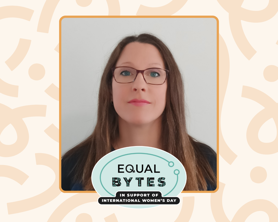Growing awareness of the gender gap in STEM professions is spurring a rising demand for women in tech.
But how did diversity in STEM (science, technology, engineering, and maths) fall by the wayside? And was it always this way? Read on as we explore why there are so few women in tech and celebrate those helping to change this.
Where are all the women in tech?
There is nothing innately male about technology. Many computing pioneers were women, including the world’s first computer programmer, Ada Lovelace.
Women were heavily involved in the development of modern computing at Bletchley Park. Computer science was once a subject that women studied in growing numbers.
Fast forward to 2017, and a diversity report by the British Computer Society reveals that only 17% of employees in the tech sector were female.
In 2020, just 19% of the IT specialists in the UK were female.
So, what drove women away from technology?
Something changed in the 1980s. The number of women studying computer science flattened. Women began to leave the technology industry in greater numbers than they were entering it. The tech sector rapidly became male-dominated.
Stereotypes in marketing and the media
One theory is that this gender imbalance emerged because of the way personal computers were first marketed: as toys for boys.
Marketing is powerful. It seeps into the public consciousness and informs the narrative surrounding a product. Early marketing campaigns for PCs and other tech products targeted young males, which meant that when people thought of computers, they thought of boys and men.
Popular eighties movies like Weird Science, in which the male hero is a computer geek, reinforced these stereotypes. Gender stereotypes surrounding technology endured the nineties and still resonate today. Just take the IT Crowd, for example.
Not enough women in the pipeline
Children internalise gender stereotypes from the media, which impacts the subjects they choose to study.
A report by Data Science Campus shows that only 35% of girls study STEM subjects beyond GCSE, compared to 80% of boys. This trend continues into university. A mere 25% of STEM graduates are women.
The gender imbalance in STEM education impacts the technology pipeline. Recruiters have a gender-biased talent pool when it comes to filling roles in the tech sector. The result? Far more men than women end up entering the technology industry.

Campaigning for change
A growing body of research is showing the industry that gender diversity makes business sense.
Women-led companies have been found to perform better than those led by men. And gender diverse research and development teams are known to increase innovation.
Campaigning organisations, like WISE, have done much to raise women’s representation in tech. Event-led communities like She Says and Brighton Digital Women are springing up nationwide to support women to succeed in the sector.
Sheryl Sandberg, COO of Facebook, has raised the profile of the cause and is active in campaigning for more women in STEM.
“No industry or country can reach its full potential until women reach their full potential. This is especially true of science and technology, where women with a surplus of talent still face a deficit of opportunity.”
As a result of growing awareness of the tech gender gap, more women are publicly sharing their experiences to support their female peers entering the industry.
Websites like Women in Technology are brimming with useful resources. Our own blog shines a light on why more women are needed in AI, shares insight from senior female industry figures, and discusses how to succeed as a woman in tech.
Why is the tech industry the right place for you?
Not only would you be battling gender bias with the potential to inspire a future generation of women, but you would also be entering a sustainable and innovative industry. The tech industry is growing, and companies are looking for the right talent to thrive within it.
The demand for IT professionals has increased by 28% year-on-year, according to the Association of Professional Staffing Companies (APSCo). With employers unable to find the right talent to fill their vacancies, there is no better time than now to get certified and enter the job market.
What can we do to help?
At Learning People, we acknowledge the gender gap in tech and are always looking for ways we can help close it. In 2019, we hosted our Closing the Gap: The Future of Women in Tech event in partnership with Triangirls at Deliveroo HQ. We also attended the Women in Business Expo to host a stand and connect with women professionals from all walks of life.
In addition to spreading awareness, we continue to offer globally recognised certifications shaped with your career in mind.
Our career experts are on hand to identify the best certifications to get you on track with your career goals. Once certified, our Career Services team will help you secure your new role in tech. They’ll give you access to a dedicated Career Services eBook, divided into 3 phases. Each phase will give insight into the job market with tailored support to guide your job search.
Get in touch with our friendly career consultants today to find out which tech career path will work best for you.
Related Articles
 Women in Tech
Women in Tech5 reasons women make great coders
If we trace the origins of computer programming, 75% of codebreakers at Bletchley Park were women and engineering at NASA was predominantly performed by women.
Read More Tech
TechInclusivity in Cyber Security | An interview with Rob Black
In this insightful conversation, Rob Black, a prominent figure in the UK cybersecurity industry, discusses the importance of creating an inclusive and supportive environment for everyone, regardless of background or gender.
Read More Women in Tech
Women in TechMary Kenneth Keller: A trailblazer for women in tech and education
Mary Kenneth Keller was a computer science pioneer who led the way for women in both tech and education. Discover her contributions and how she continues to inspire more women to pursue careers into STEM.
Read More Tech
TechLife in Cyber Security | An interview with Karine Tobin
If you're curious about breaking into cybersecurity or simply need a boost of motivation to pursue your goals, this conversation is packed with insights on resilience, the power of networking, and why finding your “why” makes all the difference.
Read More
